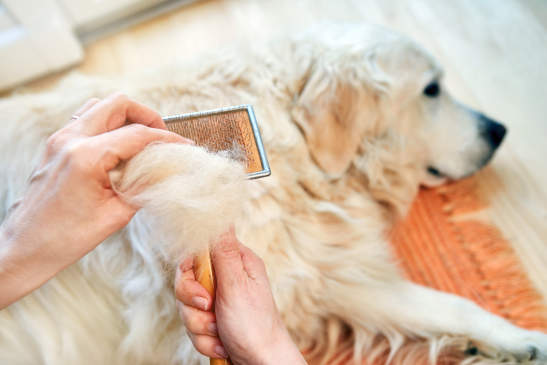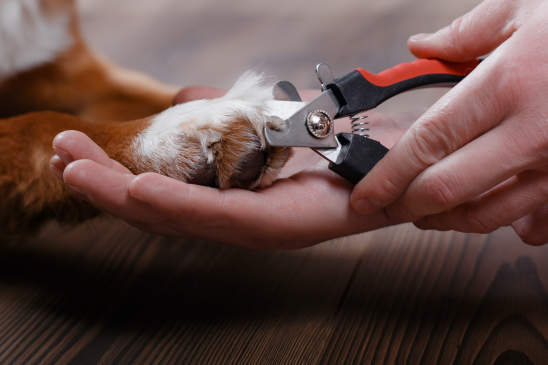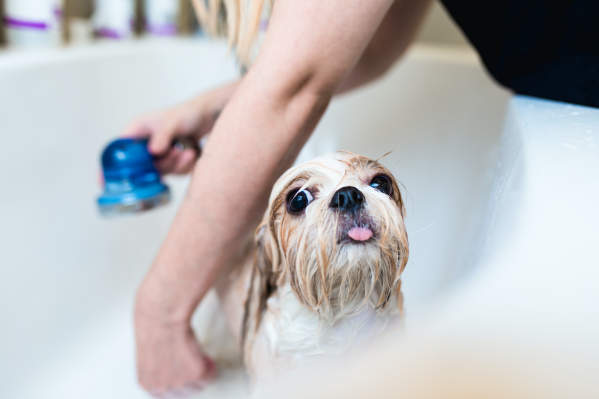All across the country (and the globe) people are sheltering in place in order to slow the spread of COVID-19. While we do our part by staying inside, many tasks we normally outsource to more competent people have seemingly fallen into our laps — like learning to do our own eyebrows and, of course, grooming our pets. This has made taking care of our pets while social distancing a little bit more challenging.
Professional dog groomers exist for a reason, and we love having them as an option. But extenuating circumstances mean expanding our skill sets... and that will include learning how to groom our fluffy little friends.
How To Brush Your Dog
If you’re new to pet grooming, keep it simple and safe. A great way to start is to brush your pet frequently to prevent matting and to keep the coat clean, thereby reducing the need for baths — as well as how much hair builds up all over your home. Brushing helps spread your dog's natural oils so that their skin and coat looks shinier and healthier.
How often you should brush your dog will depend on your particular dog's coat. Longer-haired dog breeds require more frequent brushing as they're more prone to tangling and matting. Shorter-haired dog breeds will require less frequent brushing. If your dog has matting, don't be rough; it's best to apply a dog-specific conditioner or spray. Brushing too hard can lead even the sweetest dogs to react, so always be careful.

How To Give Your Dog A Bath
Most dogs don’t love bath time, but it’s important to maintain some regularity. “Unless your dog gets especially dirty or has a health problem, they shouldn’t need a bath more frequently than every four to six weeks or so,” explains Dr. Jennifer Coates, DVM, who serves on the advisory board for Pet Life Today. If you don’t mind a little extra doggy odor, you can go even longer than that, but not TOO much longer.
Bathing them is also a great time to change the sheets and blankets they use regularly, so everything is clean and fresh at the same time.
“When a bath becomes necessary, provide your pet with a non-slip surface to stand on, use warm water and a species-specific shampoo, and be sure to rinse thoroughly,” says Dr. Coates. Do not spray your pet in the face, use a damp washcloth to clean around the eyes, ears, nose, and mouth.
Ultimately, it’s unlikely you’ll need to bathe them once a month unless they get themselves into a real mess. “Some people do this weekly, but it can damage your dog’s coat over time and leave the hair coarse,” adds Jeff Carbridge, a dog trainer and professional dog groomer at DogOwner.co.uk.

How To Trim Your Dog's Nails
How often you should clip your dog's nails will depend on their specific needs; there is no one-size-fits-all answer. But if you can hear their nails tapping on the floor as they walk, then you know they need a clip.
Nail clipping isn't necessarily an easy task, especially if the process makes your dog nervous. Dogs' nails have nerves in them, as well as blood vessels, so it's imperative you only trim the tips. If your dog's nails do start bleeding, you can use stypic powder to clot.
If you can get away with not clipping your dog's nails, it may be for the best. Unfortunately, some of us can't. "If you do decide you need to take the plunge, watch a few YouTube guides from groomers before you give it a go," says Carbridge.
How To Cut Your Dog's Hair
Dogs don’t love those haircuts, but they are necessary to avoid hair getting matted. “If your pet needs a haircut, use electric clippers, not scissors to reduce the chances that you’ll cut their skin,” explains Dr. Coates. Opt for a simple style, like a puppy cut that is the same length all over or just address the problem areas and let the rest of the fur stay longer.
"If you have a dog with a double coat, never cut this unless it is for a medical reason because you will permanently damage it,” adds Carbridge.
How To Clean Your Dog's Eyes And Ears
“This is not scary and can be done with a cotton ball - ears and eyes can be prone to infection so monthly cleaning is key,” says Alison Rutty, Rover’s Director of New Business Lines and Grooming.
To clean the eyes, use a lightly dampened cloth or cotton ball and gently wipe the area around the eyes. You should definitely refrain from wiping the eye itself.
To clean the ears, wrap a cotton ball around your finger and begin wiping the visible parts of your dog's ears. Don't stick your finger in too far either.

How To Brush Your Dog's Teeth
Oral hygiene is an important part of grooming your dog so make sure to have a dog-friendly toothpaste available. Regular tooth brushing means you can put off that visit for a professional dental cleaning for longer, which is also necessary at this time. Poor dental health leads to periodontal disease, which can, in turn, lead to a host of other health problems in your dog's liver, heart, and kidney. So don't forget!
Massage your dog-approved toothpaste onto their gums and teeth either using your finger or a toothbrush. Pull back their gums for easier access to all the teeth. This process can be alarming for dogs, so take it slow and ease your way into it. Some progress is better than no progress.
How To Express Your Dog's Anal Glands
This part isn’t fun for you or your pet, but it’s necessary. Many dogs require regular gland expression to prevent buildup or even rupturing. If your dog is scooting their butt across the carpet, licking their booty incessantly, or leaking from their anus — your dog probably needs your help.
Here's how literally anyone can do it, according to veterinary consultant, Claudine Sievert.
Put your dog on the table and ask someone to gently hold it.
Take a paper towel into your left hand.
Put a medical glove on your right hand and lubricate your index finger with KY jelly.
Slowly insert your finger into the dog's rectum 1-1.5 inches forward.
Find the gland at the 6 o'clock position (it is a firm, easily distinguishable pea-sized object).
Place a paper towel near the dog's anus and milk the gland toward you by gently pressing on it.
“Two common mistakes here are making sharp movements and putting too much pressure - please, avoid these and it will work,” says Sievert. It will help the dog to get relief and its owner to get the unpleasant smell out of the room.
